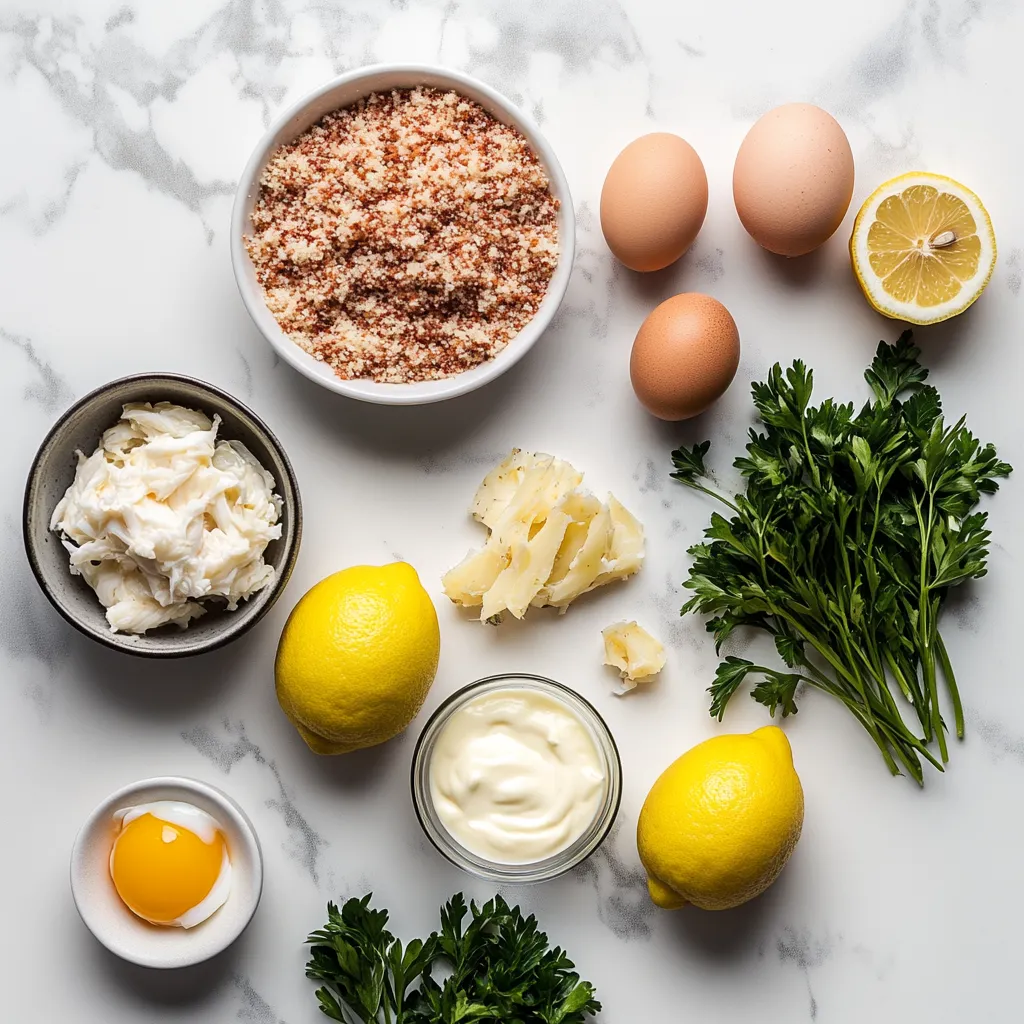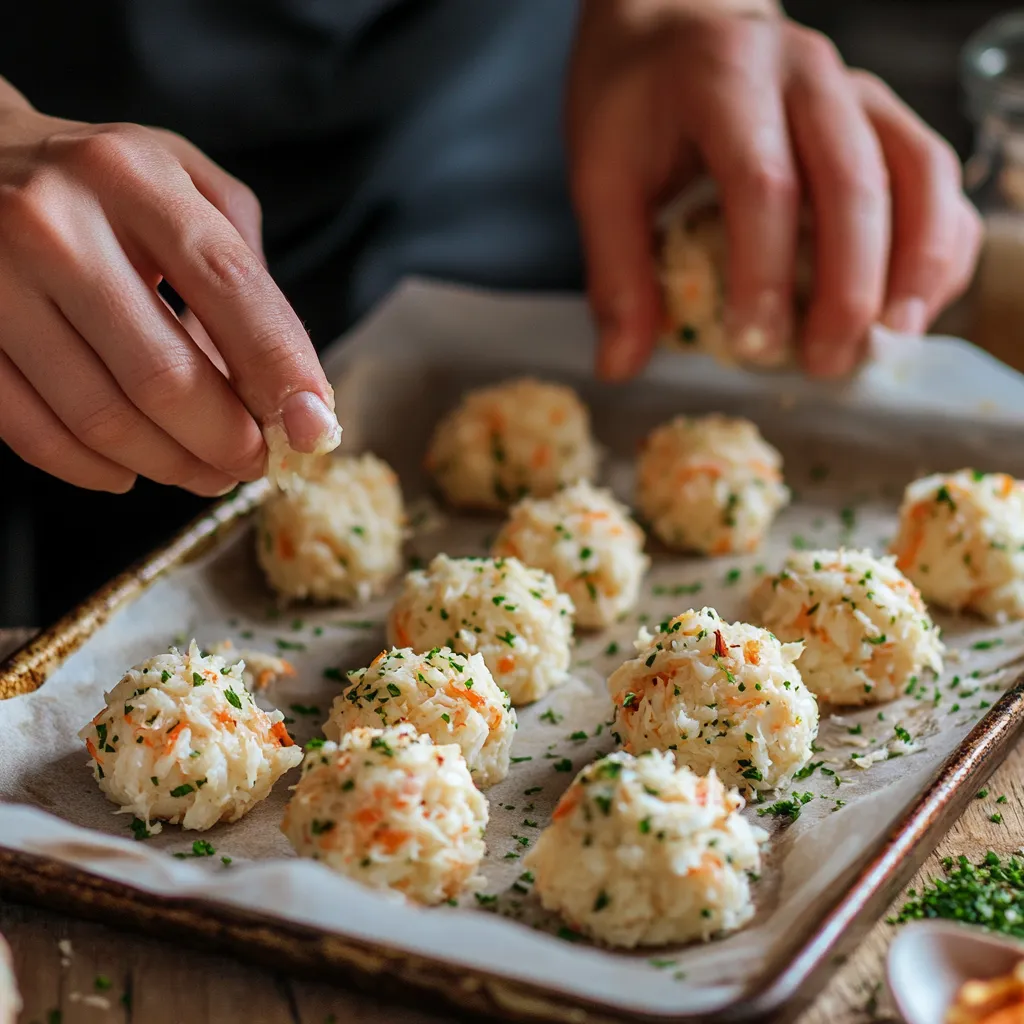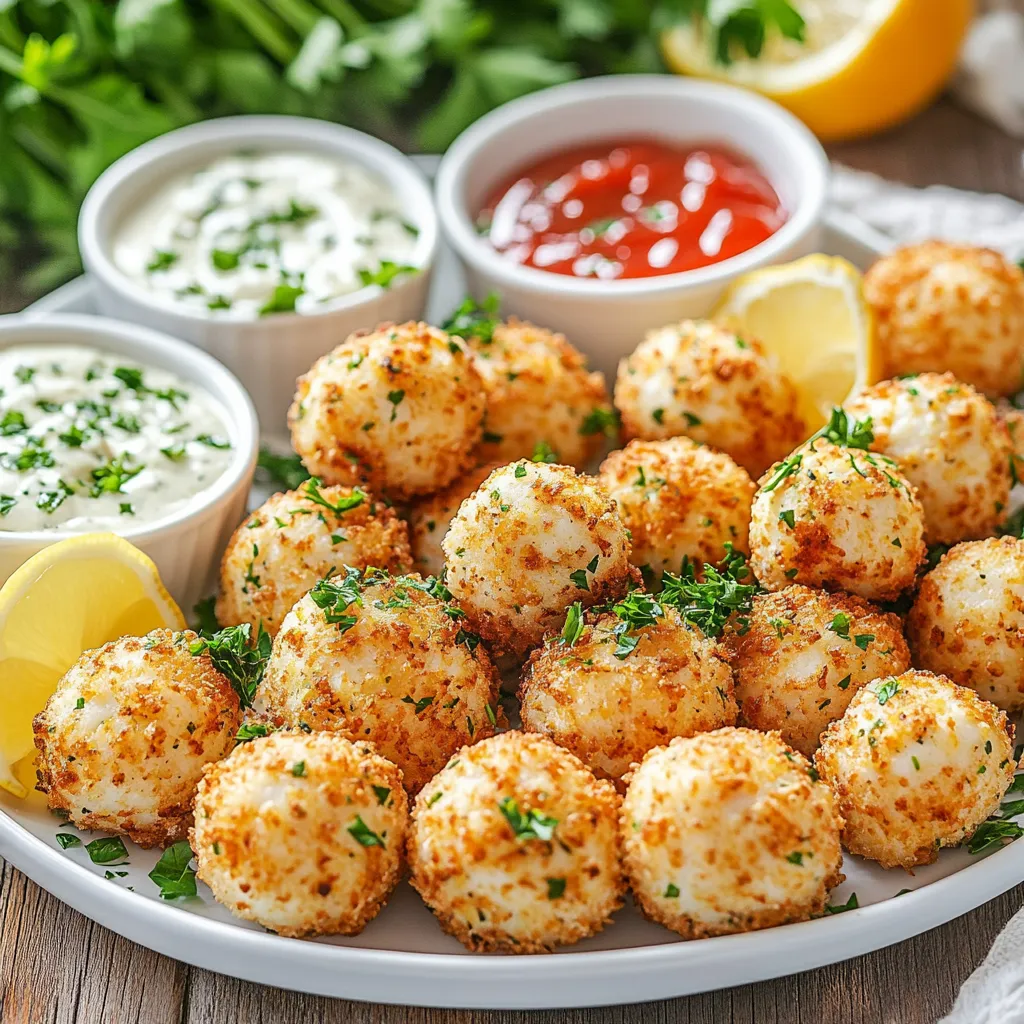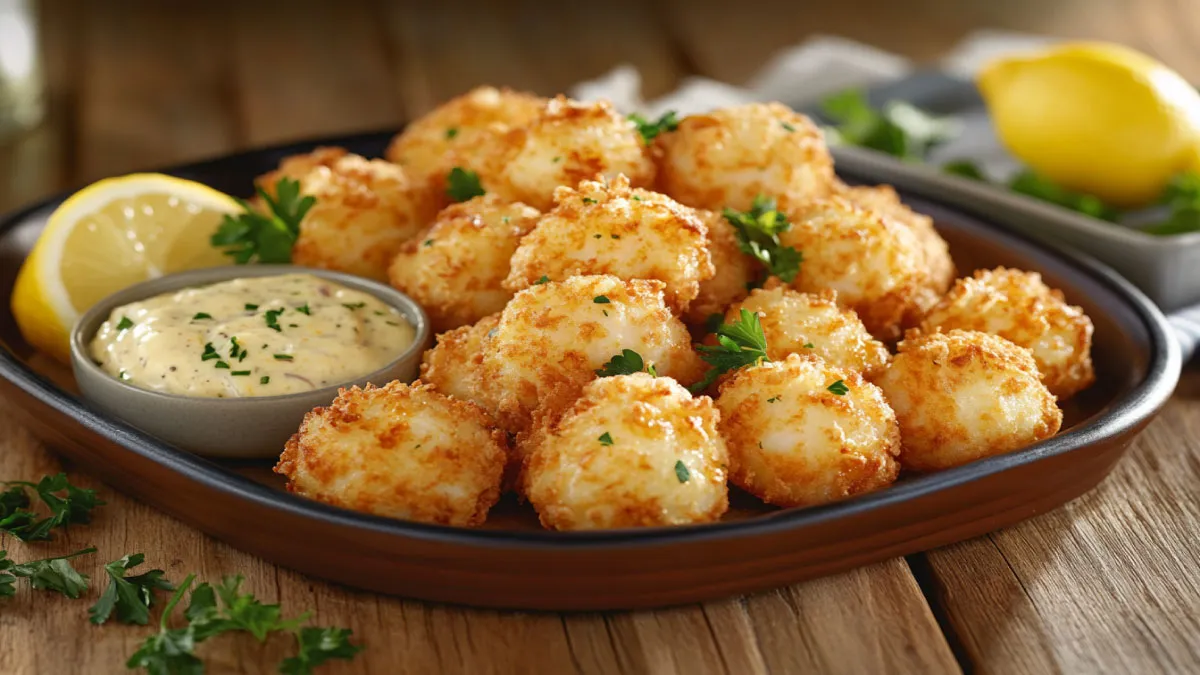A Complete Guide to Crab Balls: Recipes, Tips, and Variations
Crab balls are a crowd-pleasing appetizer that packs the bold, savory flavors of the sea into a bite-sized treat. They’re easy to make, versatile, and perfect for any occasion, whether it’s a party, a casual family dinner, or a festive holiday spread. In this article, we’ll cover everything you need to know about crab balls—from their origins to the best ways to prepare, serve, and store them. Along the way, you’ll find step-by-step instructions, ingredient tips, and creative variations to suit every taste and dietary preference. Ready to get started? Let’s dive in!
Table of Contents
What Are Crab Balls?
Understanding Crab Balls: A Delicious Bite-Sized Delight
Crab balls are small, flavorful spheres made from a mixture of crab meat, breadcrumbs, seasonings, and other ingredients. Think of them as a more compact version of the beloved crab cake, with a crispy exterior and a tender, juicy center. Seafood lovers adore crab balls because they offer the rich, briny taste of crab in a convenient, handheld package.
What sets crab balls apart is their versatility. They can be baked for a healthier option, fried for extra crispiness, or even air-fried for a modern twist. Served with a variety of sauces, crab balls are a hit at parties, potlucks, and family gatherings.
Origins and Popularity of Crab Balls
The origins of crab balls trace back to regions where crabbing is a way of life, like the Chesapeake Bay area. In Maryland, for instance, crab balls are often made with blue crab, known for its sweet and delicate flavor. Over time, the recipe evolved, with home cooks and chefs experimenting with different seasonings and preparation methods.
Today, crab balls are popular across the United States and beyond, thanks to their adaptability. Whether served as an appetizer, a main course, or a snack, they’re a surefire way to impress guests without a lot of fuss.
How Crab Balls Differ from Crab Cakes
While crab balls and crab cakes share many of the same ingredients, they differ in size, texture, and presentation. Crab balls are smaller and often served as finger food, while crab cakes are typically larger and plated as a main dish.
Another key difference is the cooking method. Crab cakes are usually pan-fried or broiled, but crab balls are often deep-fried or baked to achieve that irresistible crunch. Both options highlight the rich taste of crab meat, but crab balls are especially popular for their convenience and fun size.
Why Crab Balls Are a Party Favorite
What makes crab balls such a hit at parties? For starters, they’re easy to eat. Their small size and crispy texture make them the perfect finger food for mingling guests. Plus, they pair wonderfully with a variety of dips, from classic tartar sauce to zesty aioli.
Another reason crab balls shine at gatherings is their ability to fit different themes. Whether you’re hosting a seafood boil, a backyard BBQ, or a holiday feast, crab balls are a natural choice. Add some fresh parsley and lemon wedges for a festive touch, and you’ve got a dish that’s as visually appealing as it is delicious.
Ingredients for the Perfect Crab Balls
Key Ingredients for Making Delicious Crab Balls
The secret to amazing crab balls starts with the right ingredients. Using fresh, high-quality items makes all the difference. From the crab meat to the seasonings, every ingredient plays a role in creating the perfect balance of flavor and texture.
| Ingredient | Quantity | Notes |
|---|---|---|
| Lump Crab Meat | 1 pound | Fresh for the best results |
| Breadcrumbs | 1 cup | Plain or seasoned |
| Egg | 1 large | Acts as a binder |
| Mayonnaise | 1/4 cup | Adds moisture |
| Dijon Mustard | 2 tsp | Adds tanginess |
| Old Bay Seasoning | 1 tbsp | Essential for authentic flavor |
| Parsley | 2 tbsp | Chopped fresh |
| Lemon Juice | 1 tbsp | For freshness |

Types of Crab Meat: Fresh vs. Imitation
When it comes to crab meat, fresh is always the top choice. Lump crab meat is ideal because it’s tender, sweet, and easy to work with. If you’re aiming for the best results, go for fresh or pasteurized crab meat from your local seafood market.
That said, imitation crab meat can work in a pinch. It’s more affordable and widely available, but the taste won’t be as rich. If you’re using imitation crab meat, consider adding extra seasonings to enhance the flavor.
Essential Seasonings for Authentic Flavor
Seasonings bring crab balls to life. Old Bay seasoning is a must—it’s a classic choice that delivers the perfect blend of salty, spicy, and herbal notes. Adding a touch of Dijon mustard and fresh lemon juice can also brighten the dish.
Other spices, like garlic powder, onion powder, and paprika, can add depth to the flavor. Don’t forget fresh parsley for a hint of freshness and color. A dash of salt and pepper ties everything together beautifully.
Best Additions for Texture and Taste
Texture is just as important as taste when it comes to crab balls. Breadcrumbs are essential for binding the mixture and creating a crispy exterior. You can use plain breadcrumbs for a neutral base or panko for extra crunch.
Eggs are another key ingredient, helping hold the mixture together without making it too dense. For creaminess, a dollop of mayonnaise does wonders. These ingredients work together to ensure that your crab balls hold their shape and have a satisfying bite.
Step-by-Step Recipe
Cooking Crab Balls: Methods and Tips
Making crab balls is a fun and rewarding process. By following the steps below, you’ll end up with perfectly cooked, crispy bites every time. Whether you prefer baking, frying, or air-frying, this recipe has you covered.
Preparing the Mixture: Getting the Right Consistency
The first step is mixing the ingredients. In a large bowl, combine the crab meat, breadcrumbs, egg, mayonnaise, Dijon mustard, Old Bay seasoning, parsley, and a splash of lemon juice. Mix gently to avoid breaking the crab meat into tiny pieces.
The mixture should feel moist but not sticky. If it’s too wet, add a bit more breadcrumbs. If it feels too dry, a little mayonnaise or water can fix that. The key is finding the perfect balance so the crab balls stay firm but tender.
Shaping and Portioning Crab Balls
Next, shape the mixture into balls. Using a small ice cream scoop or a spoon helps you portion them evenly. Each ball should be about 1–2 inches in diameter—small enough to be bite-sized but big enough to hold their shape.
Once you’ve shaped the balls, place them on a tray lined with parchment paper. For best results, chill the tray in the fridge for 15–20 minutes. This step helps the balls hold their shape during cooking.

Cooking Options: Baked, Fried, or Air-Fried
There are several ways to cook crab balls, depending on your preference:
- Baking: Preheat your oven to 375°F (190°C). Arrange the crab balls on a greased baking sheet. Bake for 15–20 minutes, turning them halfway through for even browning.
- Frying: Heat oil in a deep skillet or fryer to 350°F (175°C). Fry the balls in batches for 3–4 minutes, or until golden brown. Place them on paper towels to drain excess oil.
- Air-Frying: Preheat your air fryer to 375°F (190°C). Arrange the crab balls in a single layer and cook for 12–15 minutes, shaking the basket halfway through.
Each method creates delicious crab balls, but frying gives the crispiest results. Baking and air-frying are great alternatives if you want a healthier option.
Troubleshooting Common Mistakes
If your crab balls fall apart during cooking, the mixture might be too dry or too loose. Adjust the moisture levels by adding more mayonnaise or breadcrumbs as needed.
For uneven cooking, make sure all the balls are the same size. Also, avoid overcrowding the pan or fryer, as this can cause the temperature to drop and make the crab balls greasy.
Serving Ideas and Pairings
Perfect Pairings for Crab Balls
When it’s time to serve your crab balls, a great presentation and the right pairings can elevate the dish. Crab balls are wonderfully versatile and pair well with many side dishes, sauces, and beverages. With a few simple ideas, you can transform your crab balls into a crowd-pleasing masterpiece.
Best Sauces: Tartar, Aioli, and More
No crab balls are complete without a good dipping sauce. Tartar sauce is a classic choice, offering a creamy, tangy flavor that complements the sweet crab meat perfectly. If you’re looking for something bolder, try garlic aioli or a spicy remoulade sauce.
For a zesty kick, consider serving your crab balls with a drizzle of lemon butter or a side of cocktail sauce. These sauces are easy to prepare and can be made ahead of time, saving you effort on the day of your event.

Drinks That Complement Crab Balls
Pairing crab balls with the right drink enhances the overall dining experience. A crisp white wine, such as Sauvignon Blanc or Chardonnay, brings out the natural sweetness of the crab. For beer lovers, a light lager or a wheat beer works wonderfully.
If you prefer non-alcoholic options, iced tea with a squeeze of lemon or a sparkling water infused with herbs and citrus can add a refreshing touch. Whatever you choose, the key is to keep the flavors light and balanced.
Creative Serving Ideas for Parties
Crab balls shine as party appetizers, especially when presented creatively. Arrange them on a platter with garnishes like fresh parsley, lemon wedges, and colorful dipping sauces. For an upscale twist, serve them on small plates with a dollop of sauce and a sprinkle of microgreens.
Another idea is to skewer the crab balls on toothpicks for a fun, easy-to-grab snack. You could also create a seafood platter featuring crab balls alongside shrimp cocktail, smoked salmon, and mini lobster rolls for an impressive spread.
If you’re curious about other seafood recipes that pair well with crab balls, check out the best kokanee salmon recipe on Alexia Recipes. It’s a perfect addition to any seafood feast!
Healthier Alternatives and Dietary Options
Making Crab Balls Healthier Without Sacrificing Flavor
If you’re looking for a lighter version of crab balls, there are plenty of ways to make them healthier while keeping the taste intact. Simple substitutions and cooking methods can cut down on calories without compromising the dish’s signature flavors.
Substitutions for a Low-Calorie Option
To reduce the calorie count, swap regular mayonnaise for a light or Greek yogurt-based alternative. This keeps the mixture creamy while lowering the fat content. Using whole wheat breadcrumbs instead of traditional ones adds fiber without sacrificing texture.
Another tip is to use less oil by baking or air-frying the crab balls instead of deep-frying them. These methods produce a crispy exterior without adding unnecessary grease.
Gluten-Free Variations
For those avoiding gluten, it’s easy to modify crab balls to meet dietary needs. Replace the breadcrumbs with gluten-free alternatives, like almond flour or crushed gluten-free crackers. You can also use gluten-free panko for a similar crunch.
Be sure to double-check that your seasonings, especially Old Bay, are gluten-free. Many spice blends are naturally gluten-free, but it’s always good to confirm.
How to Make Crab Balls Keto-Friendly
Keto-friendly crab balls are an excellent option for those following a low-carb diet. To achieve this, substitute the breadcrumbs with pork rind crumbs or almond flour. These alternatives provide a crunchy texture while keeping the carb count low.
Additionally, opt for sugar-free sauces and dressings to complement your crab balls without adding unnecessary carbohydrates. Keto crab balls can be baked or air-fried for a healthy, delicious snack.
By adjusting the ingredients and cooking methods, you can easily adapt crab balls to suit different dietary needs. These healthier versions retain all the flavor and texture of the original recipe while accommodating specific preferences.
FAQs
Can You Freeze Crab Balls?
Yes, crab balls freeze beautifully, making them an excellent make-ahead option. To freeze uncooked crab balls, place them on a baking sheet lined with parchment paper and freeze until firm. Once frozen, transfer them to an airtight container or freezer bag.
When you’re ready to cook, simply bake or fry them directly from frozen. Add a few extra minutes to the cooking time to ensure they’re heated through. Cooked crab balls can also be frozen, but reheating them may slightly affect the crispness of the exterior.
How Long Do Crab Balls Last in the Fridge?
If stored properly, crab balls can last up to three days in the refrigerator. Place them in an airtight container and keep them on a shelf toward the back of the fridge, where the temperature is more consistent.
To reheat, use an oven or air fryer to help restore their crispiness. Avoid using a microwave, as it can make them soggy.
What Are the Best Crabs for Crab Balls?
The best crabs for making crab balls are fresh or pasteurized crab meat. Blue crab is a popular choice due to its sweet and tender flavor, especially in Maryland-style recipes.
However, you can also use other varieties like Dungeness or snow crab, depending on what’s available in your area. If fresh crab meat is hard to find, pasteurized lump crab meat is an excellent alternative. Avoid canned crab meat, as it tends to have a less desirable texture and flavor.
By addressing these common questions, you’ll be better prepared to make and enjoy crab balls anytime. Next, we’ll cover storage and reheating tips to keep your leftovers just as tasty as when they were first made.
Tips for Storing and Reheating Crab Balls
Keep Them Fresh: Storage and Reheating Tips
Proper storage is the key to maintaining the flavor and texture of crab balls. If you have leftovers, place them in an airtight container and store them in the fridge for up to three days. Make sure they’re completely cooled before refrigerating to prevent condensation, which can make them soggy.
When it’s time to reheat, the oven or air fryer is your best friend. Preheat your oven to 350°F (175°C), place the crab balls on a baking sheet, and heat for about 10 minutes, or until warmed through. Using an air fryer at the same temperature for 5–7 minutes will also help bring back their crispness.
Avoid reheating crab balls in the microwave, as this method often leads to a rubbery texture and a loss of that crunchy exterior. If you’ve frozen cooked crab balls, thaw them overnight in the fridge before reheating.
With these tips, you can enjoy perfectly warm and crispy crab balls even after they’ve been stored. For more recipe ideas and tips, consider browsing Alexia Recipes for additional culinary inspiration!
Let me know if you’d like a conclusion to tie everything together or further sections to expand on the topic.
